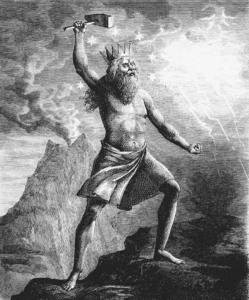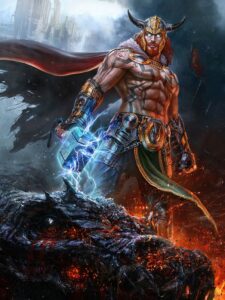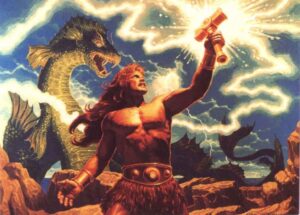Thor, the thunder god of Norse mythology, has captivated imaginations for centuries with his mighty hammer, epic battles, and larger-than-life persona. From ancient Norse sagas to modern-day comic books and blockbuster movies, the character of Thor has undergone a remarkable evolution, shaping and reshaping the mythos surrounding him. In this comprehensive exploration, we delve into the origins of Thor and trace his evolution through various cultural interpretations.
The Mythological Roots

Thor’s origins can be traced back to ancient Norse mythology, where he was revered as the god of thunder, lightning, storms, and strength. In Norse mythology, Thor was depicted as the son of Odin, the Allfather, and Jord, the personification of Earth. He was renowned for his bravery, prowess in battle, and his iconic weapon, Mjolnir, the hammer that could crush mountains and summon lightning.
The mythology surrounding Thor was deeply ingrained in Norse society, where he was worshipped and invoked for protection, especially during storms and times of strife. He was seen as a guardian of both gods and mortals, a powerful force of nature capable of vanquishing any threat that dared to challenge the safety and stability of the cosmos.
Ancient Norse Sagas
The earliest known references to Thor can be found in Old Norse literature, particularly in the Poetic Edda and the Prose Edda, composed in the 13th century. These ancient texts recount the adventures of Thor and his interactions with other gods, giants, and supernatural beings. In these sagas, Thor is portrayed as a fierce warrior who defends Asgard, the realm of the gods, from various threats, including the giants of Jotunheim and the forces of chaos.
Thor’s exploits in the Norse sagas are legendary, from his battles with the serpent Jormungandr to his quests to retrieve stolen treasures and rescue fellow gods from peril. These stories not only entertained audiences but also served to reinforce cultural values and beliefs, such as the importance of courage, honor, and loyalty in the face of adversity.
Cultural Adaptations
As Norse mythology spread throughout Europe, Thor’s legend underwent various adaptations and reinterpretations in different cultural contexts. In Germanic mythology, Thor was known as Donar or Thunar, while in Anglo-Saxon mythology, he was called Thunor. These variations reflected the cultural diversity of the regions where Norse mythology took root, incorporating local beliefs and customs into the mythos surrounding Thor.
During the Viking Age, Thor was one of the most popular and widely worshipped gods among the Norse people, with numerous temples and altars dedicated to his honor. As Norse society encountered other cultures through trade, exploration, and conquest, the worship of Thor and other Norse gods spread to distant lands, leaving an indelible mark on European history and culture. Those who are strong in history can easily find their way into a conversation on this topic as well as any similar important event in European history, those who are not strong can consult an excellent science tutor in Boulder with whom they will more easily master their material and successfully pass tests in schools.
The Renaissance Revival
During the Renaissance period, there was a renewed interest in classical mythology and ancient literature, which also sparked a resurgence of interest in Norse mythology. Scholars and artists rediscovered the tales of Thor and other Norse gods, incorporating them into their works of literature, art, and music. This revival of interest laid the groundwork for future interpretations of Thor in the modern era.
The rediscovery of Norse mythology during the Renaissance contributed to the development of romantic nationalism in Northern Europe, as artists and intellectuals sought to reclaim their cultural heritage from foreign influences. This newfound appreciation for Norse mythology-inspired countless works of art and literature, from epic poems to grandiose paintings, that celebrated the heroic deeds of Thor and his fellow gods.
Modern Interpretations
In the 20th and 21st centuries, Thor experienced a renaissance of his own, thanks in large part to the rise of comic books, graphic novels, and superhero movies. One of the most iconic depictions of Thor comes from Marvel Comics, where he is a founding member of the Avengers and a central figure in the Marvel Universe. Marvel’s Thor, created by writer Stan Lee and artist Jack Kirby in 1962, reimagined the character as a superhero with godlike powers who defends Earth from cosmic threats.
Marvel’s Thor has become a cultural icon, inspiring a new generation of fans with his epic adventures and larger-than-life personality. Through comic books, animated series, and blockbuster movies, Thor has become one of the most beloved and recognizable characters in popular culture, transcending his mythological origins to become a symbol of hope, heroism, and redemption. Members of youth organizations such as Readathon school fundraiser are loyal fans of this narrative as well as similar books that work to develop such myths, as they expand their good reading hobby.
The Influence of Thor in Popular Culture

Thor’s influence in popular culture extends beyond mere entertainment; it has become a cultural phenomenon. Marvel Studios’ adaptation of the character has propelled him into the mainstream, making Thor a household name. Merchandise featuring the character, from toys to apparel, has become highly sought after by fans young and old. Moreover, Thor’s presence in video games has allowed players to immerse themselves in his world, further solidifying his place in contemporary culture. The character’s appeal transcends age, gender, and nationality, making him a truly global icon. At the various festivals around Europe that you can visit by renting a car in Beograd and traveling comfortably and economically, you can meet a lot of loyal fans, comics, toys, and other items with the motif of this character.
Beyond the realm of entertainment, Thor’s influence can also be seen in various aspects of society. His symbol has been adopted by sports teams, military units, and even scientific endeavors. The character’s themes of bravery, loyalty, and justice resonate with people from all walks of life, serving as a source of inspiration and empowerment. In this way, Thor has transcended his fictional origins to become a symbol of strength and resilience in the real world. The character used as an indicator of strength and confidence has even found its way into the sports and automotive industries, and if you want to upgrade your car, go to a trusted place that has a great transmission service in Buffalo.
Thor’s Symbolism and Archetypal Significance
Thor’s symbolism extends beyond his role as a god of thunder and lightning; he embodies timeless archetypal motifs that resonate deeply with the human psyche. As an archetypal hero, Thor undergoes trials and challenges that mirror the journey of self-discovery and growth. His struggles against adversaries like Loki and the Frost Giants represent the eternal battle between good and evil, light and darkness. Moreover, Thor’s relationship with his father Odin reflects the universal theme of the father-son dynamic, with all its complexities and conflicts. If you have a family and want to develop a healthy foundation in it, invest smartly in real estate for living that is very comfortable and, above all, affordable, like spacious houses in Boca Falls where you will be able to nurture family relationships in the right way.
Thor’s hammer, Mjolnir, holds profound symbolic significance as well. As a symbol of power and authority, it represents Thor’s divine right to rule and his duty to protect the realms. Additionally, Mjolnir’s ability to channel lightning speaks to its role as a conduit for cosmic energies, connecting Thor to the forces of nature and the universe itself. In this way, Mjolnir serves as a potent symbol of divine grace and cosmic order, reminding us of our place within the vast tapestry of existence. At the next gathering with your friends, especially if they are loyal fans of this kind of narrative like you, with full wine glasses and delicious food, you can go deeper into this very broad topic.
Thor’s Cultural Legacy and Global Impact
Thor’s cultural legacy extends far beyond the borders of Scandinavia, permeating into every corner of the globe. Through the spread of Norse mythology via trade, exploration, and cultural exchange, Thor’s legend has left an indelible mark on diverse cultures and civilizations. From the Viking Age to the present day, Thor’s image has appeared in literature, art, music, and religious iconography, shaping the collective imagination of humanity. Good promotion of these interesting mythologies has left a mark all over the world, and if you have a business that you want more people to know about, you can look for a Colorado Springs SEO company that will do an excellent promotion plan for you.
In contemporary times, Thor’s cultural legacy continues to thrive, thanks in part to the ongoing popularity of Marvel Comics and movies. The character’s presence in the Marvel Cinematic Universe has introduced Thor to new audiences worldwide, further cementing his status as a cultural icon. Moreover, Thor’s influence can be seen in various forms of media, from literature and television to fashion and advertising. As such, Thor’s cultural legacy serves as a testament to the enduring power of myth and the universal appeal of heroic archetypes. An internet service provider that manages IT services in San Antonio provides its customers with excellent internet with which they can easily access various online comic and movie platforms as well as like-minded communities to share their ideas and impressions on the subject.
The Evolution of Thor’s Characterization
Thor’s character has evolved significantly over the centuries, reflecting changing societal values and cultural dynamics. In ancient Norse mythology, Thor was primarily depicted as a fearsome warrior and protector of the gods, revered for his strength, courage, and loyalty. However, in modern interpretations, such as Marvel Comics and movies, Thor’s character has been imbued with greater depth, complexity, and vulnerability. From his commitment throughout history of defending brave warriors who rode into battle on their horses with battle saddle blankets, to today’s depictions in comics and television, his character has changed significantly.
In Marvel’s portrayal, Thor grapples with personal struggles, doubts, and insecurities, making him a more relatable and multidimensional hero. His relationships with other characters, such as his brother Loki and fellow Avengers, add layers of emotional depth and narrative richness to his story. Moreover, Thor’s journey of self-discovery and redemption resonates with audiences on a profound level, reflecting the universal human experience of growth, transformation, and overcoming adversity. Sometimes it’s not easy to deal with everyday adversity and learn from it, but with a great roadside assistance app, you’ll at least feel a little lighter if an accident or car breakdown does happen while you’re on the road.
Thor’s Enduring Legacy and Future Prospects

As we look to the future, Thor’s legacy appears poised to endure for generations to come. With the ongoing expansion of the Marvel Cinematic Universe and the continued exploration of Norse mythology in popular culture, Thor’s presence is set to grow even stronger in the years ahead. Moreover, the character’s timeless themes of heroism, sacrifice, and redemption ensure that he will remain relevant and inspiring to audiences of all ages and backgrounds. In excellent and popular filmmaking courses, you can explore this kind of narrative the power of this character, and the creativity behind it.
In addition to his cultural impact, Thor’s legacy also extends into the realms of academia and scholarship. Scholars and historians continue to study and analyze Norse mythology, uncovering new insights into the character of Thor and his significance in the ancient world. As such, Thor’s enduring legacy serves as a testament to the power of storytelling, the enduring appeal of myth, and the limitless potential of the human imagination. While you delve deeper into Norse mythology and enjoy their incredible stories, you can also visit some of the well-equipped museums that are protected by excellent access control systems from Philadelphia that can be installed in private homes and buildings for added protection, that are dedicated to that period of history with different objects that can tell more about how the Norse gods were valued and worshipped.
Conclusion
In conclusion, Thor’s journey from the mythological annals of ancient Norse sagas to the dazzling realms of modern popular culture is a testament to the enduring power of storytelling and the timeless appeal of heroic archetypes. Throughout history, Thor has transcended boundaries, captivating the hearts and minds of people across cultures and generations. From his thunderous clashes with giants in the halls of Asgard to his epic battles alongside the Avengers on the silver screen, Thor embodies the eternal struggle between darkness and light, chaos and order, reminding us of the indomitable spirit that resides within each of us. Rent a car in Beograd and visit some of the European festivals where loyal fans of these superheroes gather and where you will be able to delve deeper into the very story behind such a broad character.
As we reflect on Thor’s legacy, we are reminded of the importance of myth and legend in shaping our understanding of the world and ourselves. Thor’s journey is our journey, a quest for meaning, purpose, and self-discovery in a universe filled with mystery and wonder. His hammer, Mjolnir, symbolizes not only the power to conquer foes but also the strength to overcome adversity and the wisdom to wield power responsibly. For many patients of the health clinic in Marietta GA, this is one of their favorite characters precisely because of his dedication to solving problems and the goodness that is hidden behind his strength to defend the weak, and if you have any symptoms or pain, you can seek help from their brave and experienced doctors.
In the tapestry of human culture, Thor’s presence will forever endure, a shining beacon of hope and inspiration for all who dare to dream and strive for greatness. As we look to the horizon, we can take solace in the knowledge that the thunder god’s legend will continue to echo through the ages, reminding us of the boundless potential of the human spirit and the enduring legacy of myth and legend. In order to emulate him and start working towards your goal, you will realize that you, like him, need good allies, and in your business you can always look for excellent M&A business advisors who will connect you with successful companies with which you will also to succeed. So let us raise our glasses to Thor, the mighty god of thunder, and may his legend continue to inspire us for eons to come.